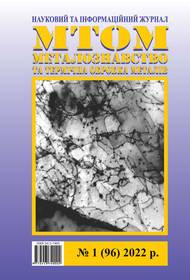EFFECT OF HEATING TEMPERATURE AND COOLING RATE ON THE FORMATION OF STRUCTURAL COMPONENTS IN STEELS
DOI:
https://doi.org/10.30838/J.PMHTM.2413.240422.44.842Keywords:
heating steels over the liquidus line, cooling rate, heat treatment, structural stateAbstract
Formulation of the problem. One of the key areas of research into the mechanical properties of steels lies in developing methods of manufacturing steels with a grain structure and a high degree of carbides dispersion or other inclusions that will be located in the pearlite grain as a result of heat treatment. Changes in external factors such as temperature, pressure etc. are known to cause changes in the structural components of alloys and steels. The most usual way of fixing the high-temperature state for metal systems is through hardening, which is the removal of heat at high rateIt is known that microcomplexes formation is possible in melts at temperatures exceeding the liquidus temperature. There is much research of melts at temperatures above liquids for the presence of stable microcomplexes in binary alloys. However, there are no data on heat flow above the liquidus line for phase formation during crystallization and the structural components formation in steels. Purpose of research − investigation of chemical composition effect and heating temperature above the liquidus line and cooling rate on the structure formation in steels. Methods. Microstructural, micro X-ray spectral and X-ray phase analyses to determine the steel structural properties are used. Results. A new type of heat treatment including heating of the experimental steels with the alloy system (K + (Al + N + Ti)) and (K + (Al + + N) above the low-temperature line by 50...150 ºC is suggested and investigated. Subsequent cooling at rates of
102…105 ºС to fix the melt high-temperature state after experimental steels heating over the liquidus line by
50…150 ºС is performed. As a result of such processing the dispersed structure which is strengthened by dispersed inclusions is formed. The inclusions were < 0,1 μm in size and were evenly distributed in the grain volume and partially along the boundaries. The martensite formed by the steel rapid cooling had a finely differentiated and rail-like morphology. Scientific novelty. A new method of steel processing is proposed. Regularities of structural components formation in the heat treatment process including steels’ heating over the liquidus line by 150…170 ºС is determined. Practical significance. This method of thermal action influence allows to receive the homogeneous structure strengthened by dispersed inclusions. The method allows choosing the optimal modes of differentiated heat treatment to obtain the most homogeneous structural state and specified mechanical properties.

Downloads
Published
Issue
Section
License
Authors that are published in this journal agree to follow the conditions:
Authors reserve the right to the authorship of his work and cede the right to the journal of first publication of this work on conditions of the license under the Creative Commons Attribution License, which allows others to distribute it freely with the obligatory reference to the author of the original work and the first publication of the work in this journal.
